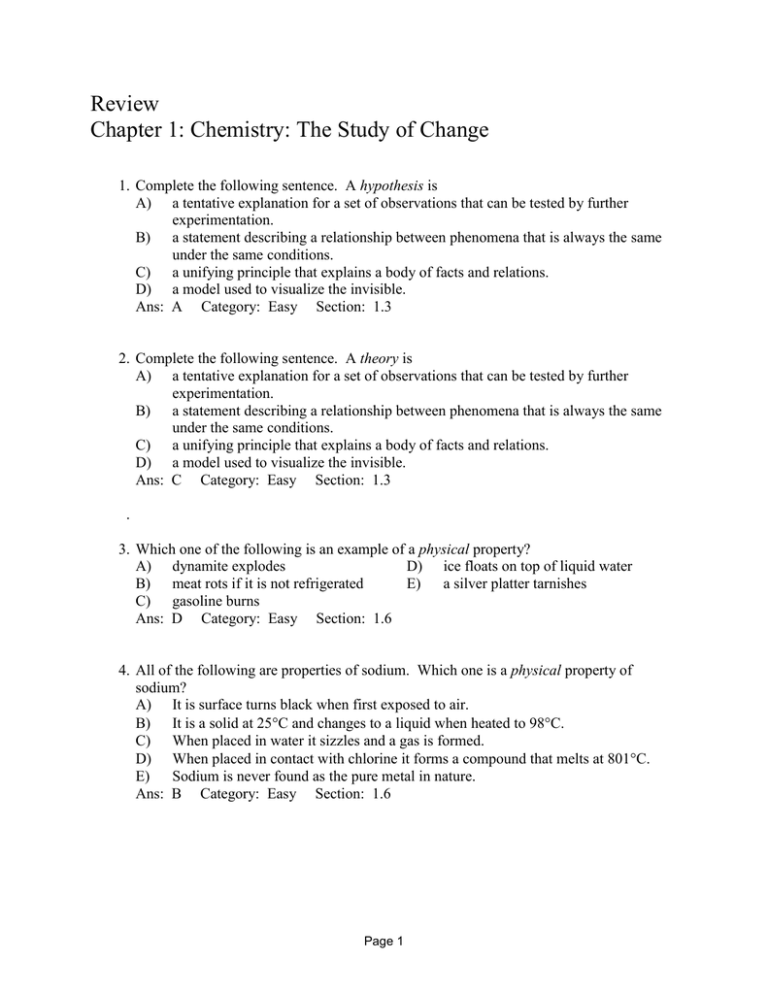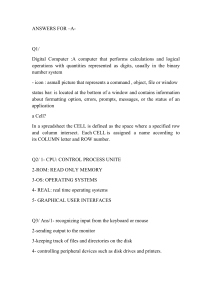Review Chapter 1: Chemistry: The Study of Change
advertisement

Review Chapter 1: Chemistry: The Study of Change 1. Complete the following sentence. A hypothesis is A) a tentative explanation for a set of observations that can be tested by further experimentation. B) a statement describing a relationship between phenomena that is always the same under the same conditions. C) a unifying principle that explains a body of facts and relations. D) a model used to visualize the invisible. Ans: A Category: Easy Section: 1.3 2. Complete the following sentence. A theory is A) a tentative explanation for a set of observations that can be tested by further experimentation. B) a statement describing a relationship between phenomena that is always the same under the same conditions. C) a unifying principle that explains a body of facts and relations. D) a model used to visualize the invisible. Ans: C Category: Easy Section: 1.3 . 3. Which one of the following is an example of a physical property? A) dynamite explodes D) ice floats on top of liquid water B) meat rots if it is not refrigerated E) a silver platter tarnishes C) gasoline burns Ans: D Category: Easy Section: 1.6 4. All of the following are properties of sodium. Which one is a physical property of sodium? A) It is surface turns black when first exposed to air. B) It is a solid at 25C and changes to a liquid when heated to 98C. C) When placed in water it sizzles and a gas is formed. D) When placed in contact with chlorine it forms a compound that melts at 801C. E) Sodium is never found as the pure metal in nature. Ans: B Category: Easy Section: 1.6 Page 1 Chapter 1: Chemistry: The Study of Change 5. The SI prefixes nano and deci represent, respectively: A) 10–9 and 10–6. D) 109 and 10–6. 6 –3 B) 10 and 10 . E) 10–9 and 10–1. 3 –3 C) 10 and 10 . Ans: E Category: Easy Section: 1.7 6. A microliter corresponds to: A) 10 liters. B) 10–3 liters. C) 10–6 liters. Ans: C Category: Easy Section: 1.7 –2 D) 10–9 liters. 7. Express 7,500 nm as picometers. A) 7.50 pm B) 75.0 pm C) 750 pm D) 7.5 106 pm Ans: D Category: Medium Section: 1.7 E) 10–12 liters. E) 7.5 1012 pm 8. Which of the following represents the largest mass? A) 2.0 102 mg D) 2.0 102 cg B) 0.0010 kg E) 10.0 dg 5 C) 1.0 10 ng Ans: D Category: Medium Section: 1.7 9. Many home freezers maintain a temperature of 0F. Express this temperature in C. A) –32C B) –18C C) 0C D) 18C E) 57.6C Ans: B Category: Medium Section: 1.7 10. The highest temperature ever recorded in Phoenix, Arizona, was 122F. Express this temperature in C. A) 50.0C B) 64.4C C) 67.8C D) 162.0C E) 219.6C Ans: A Category: Medium Section: 1.7 11. Liquid nitrogen boils at –195.8C. Express the boiling point of liquid nitrogen in F. A) –384.4F B) –352.4F C) –320.4F D) –140.8F E) –76.8F Ans: C Category: Medium Section: 1.7 12. The number 1.050 109 has how many significant figures? A) 2 B) 3 C) 4 D) 9 E) 13 Ans: C Category: Easy Section: 1.8 Page 2 Chapter 1: Chemistry: The Study of Change 13. How many significant figures are there in 1.3070 g? A) 6 B) 5 C) 4 D) 3 E) 2 Ans: B Category: Easy Section: 1.8 15. Express the fraction 1/51 in scientific notation to 3 significant figures. A) 2 10–2.00 D) 1.97 10–2 B) 2.0 10–2.00 E) 2.00 10–2 C) 1.96 10–2 Ans: C Category: Medium Section: 1.8 16. When 7.02C is converted to the Fahrenheit scale, how many significant figures are there in the F result? A) 1 B) 2 C) 3 D) 4 E) 5 Ans: C Category: Medium Section: 1.8 17. A barrel of oil contains 42.0 gallons. How many liters is this? (1L = 1.06 qt) A) 9.9 L B) 11 L C) 142 L D) 158 L E) 178 L Ans: D Category: Easy Section: 1.9 18. What is the volume, in cubic inches, of a brick that is 4.0 in 2.7 in 8.0 in? A) 15 in3 B) 51 in3 C) 78 in3 D) 87 in3 E) 150 in3 Ans: D Category: Easy Section: 1.9 19. What is the volume, in cubic centimeters, of a brick that is 4.0 in 2.7 in 8.0 in? A) 5.3 cm3 B) 53 cm3 C) 87 cm3 D) 4.8 102 cm3 E) 1.4 103 cm3 Ans: E Category: Medium Section: 1.9 20. If the price of gasoline is $2.99 per U.S. gallon, what is the cost per liter? (1 L = 1.06 qt) A) $0.30/L B) $0.79/L C) $1.27/L D) $2.99/L E) $12.66/L Ans: B Category: Medium Section: 1.9 21. An aluminum beverage can contains 12.0 fluid ounces of liquid. Express this volume in liters. (1 fl oz = 29.6 mL) A) 4.07 10-2 L B) 0.355 L C) 0.407 L D) 2.46 L E) 3.55 102 L Ans: B Category: Easy Section: 1.9 Page 3 Chapter 1: Chemistry: The Study of Change 22. Calculate the mass of the air contained in a room that measures 2.50 m 5.50 m 3.00 m (density of air = 1.29 g/dm3 at 25C). A) 3.13 10 –5 g B) 32.0 kg C) 53.2 kg D) 53.2 g E) None of the above. Ans: C Category: Medium Section: 1.9 Chapter 2: Atoms, Molecules, and Ions A periodic table is required to work many of the problems in this chapter. 1. In a cathode ray tube A) electrons pass from the anode to the cathode. B) electrons pass from the cathode to the anode. C) protons pass from the anode to the cathode. D) protons pass from the cathode to the anode. Ans: B Category: Medium Section: 2.2 2. The elements in a column of the periodic table are known as A) metalloids. B) a period. C) noble gases. D) a group. E) nonmetals. Ans: D Category: Easy Section: 2.4 3. Which of the following elements is most likely to be a good conductor of electricity? A) N B) S C) He D) Cl E) Fe Ans: E Category: Easy Section: 2.4 4. An anion is defined as A) a charged atom or group of atoms with a net negative charge. B) a stable atom. C) a group of stable atoms. D) an atom or group of atoms with a net positive charge. Ans: A Category: Easy Section: 2.5 5. The scientist who determined the magnitude of the electric charge of the electron was A) John Dalton. D) Henry Moseley. B) Robert Millikan. E) R. Chang. C) J. J. Thomson. Ans: B Category: Easy Section: 2.2 Page 4 Chapter 1: Chemistry: The Study of Change 6. When J. J. Thomson discovered the electron, what physical property of the electron did he measure? A) its charge, e D) its mass, m B) its charge-to-mass ratio, e/m E) its atomic number, Z C) its temperature, T Ans: B Category: Easy Section: 2.2 7. Rutherford's experiment with alpha particle scattering by gold foil established that A) protons are not evenly distributed throughout an atom. B) electrons have a negative charge. C) electrons have a positive charge. D) atoms are made of protons, neutrons, and electrons. E) protons are 1840 times heavier than electrons. Ans: A Category: Medium Section: 2.2 8. How many neutrons are there in an atom of uranium whose mass number is 235? A) 92 B) 143 C) 235 D) 238 E) 327 Ans: B Category: Easy Section: 2.3 9. An atom of the isotope chlorine-37 consists of how many protons, neutrons, and electrons? (p = proton, n = neutron, e = electron) A) 17 p, 18.45 n, 17 e D) 17 p, 37 n, 17 e B) 17 p, 20 n, 7 e E) 20 p, 17 n, 20 e C) 17 p, 20 n, 17 e Ans: C Category: Medium Section: 2.3 10. Give the number of protons (p), electrons (e), and neutrons (n) in one atom of nickel-62. A) 28 p, 28 e, 28 n C) 62 p, 28 e, 28 n B) 28 p, 28 e, 34 n D) 62 p, 62 e, 28 n Ans: B Category: Medium Section: 2.3 11. Which one of the following elements is most likely to form a 2+ ion? A) beryllium B) carbon C) fluorine D) oxygen E) sodium Ans: A Category: Medium Section: 2.5 12. Two isotopes of an element differ in their A) symbol. D) number of protons. B) atomic number. E) number of electrons. C) atomic mass. Ans: C Category: Easy Section: 2.3 Page 5 Chapter 1: Chemistry: The Study of Change 13. An aluminum ion, Al3+, has: A) 13 protons and 13 electrons D) B) 27 protons and 24 electrons E) C) 16 protons and 13 electrons Ans: D Category: Medium Section: 2.5 14. A phosphide ion has: A) 10 protons and 13 electrons D) B) 12 protons and 15 electrons E) C) 15 protons and 15 electrons Ans: D Category: Medium Section: 2.5 13 protons and 10 electrons 10 protons and 13 electrons 15 protons and 18 electrons 18 protons and 21 electrons 15. How many protons and electrons are present in one Br– ion? A) 35 p, 35 e B) 80 p, 81 e C) 35 p, 34 e D) 35 p, 36 e E) 80 p, 34 e Ans: D Category: Medium Section: 2.5 16. Given that the ion ClO3– is named chlorate, what is the ion ClO4– named? A) chloride B) chlorite C) hypochlorite D) perchlorite E) perchlorate Ans: E Category: Medium Section: 2.7 17. What is the formula for the ionic compound formed by calcium and selenium? A) CaSe B) Ca2Se C) CaSe2 D) Ca3Se E) CaSe3 Ans: A Category: Medium Section: 2.6 18. Name the binary compound formed between barium and phosphorus. A) barium phosphorus D) barium diphosphate B) barium phosphide E) barium triphosphide C) barium phosphate Ans: B Category: Medium Section: 2.7 19. The chemical name for ClO3– is chlorate ion. Therefore, the name of HClO3 is A) hydrochloric acid D) chlorous acid B) chloroform E) chloric acid C) hydrogen trioxychloride Ans: E Category: Medium Section: 2.7 Page 6 Chapter 1: Chemistry: The Study of Change 20. Which of the following is the formula for hydrobromic acid? A) KBr B) HBr C) HBrO D) HBrO2 E) HBrO3 Ans: B Category: Medium Section: 2.7 21. The correct name for NH4NO3 is A) ammonium nitrate. D) B) ammonium nitrogen trioxide. E) C) ammonia nitrogen oxide. Ans: A Category: Medium Section: 2.7 22. The correct name for CuSO4·5H2O is A) copper sulfate acid. D) B) copper sulfate pentahydrate. E) C) copper(II) sulfate acid. Ans: D Category: Medium Section: 2.7 23. The Stock system name for As2S5 is A) arsenic(V) sulfide. D) B) diarsenic pentasulfide. E) C) arsenic(III) sulfide. Ans: A Category: Medium Section: 2.7 24. hydrogen nitrogen oxide. hydrogen nitrate. copper(II) sulfate pentahydrate. copper(V) sulfate hydrate. arsenic(V) sulfate. diarsenic sulfate. Zircon is a mineral with the empirical formula ZrSiO4. If all the zirconium is 90Zr, all the silicon is 28Si, and all the oxygen is 16O, what mass of oxygen is present in 10. g of zircon? A) 0.88 g B) 1.2 g C) 1.8 g D) 3.5 g E) 5.4 g Ans: D Category: Medium Section: 2.3 25. Which of the following elements is chemically similar to potassium? A) calcium B) arsenic C) phosphorus D) cerium E) cesium Ans: E Category: Medium Section: 2.4 Page 7




